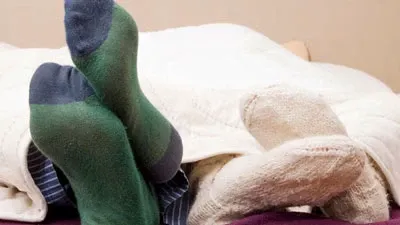
When it comes to natural home remedies, many popular "hacks" often show up online, claiming to quickly treat common problems like fever and cold.
One of these is the 'wet sock method,' which is gaining attention on social media as a way to treat fever and cold in both kids and adults. It involves wearing cold, wet socks covered by dry wool socks while sleeping, with the idea that this will help reduce fever and congestion. However, doctors warn against using this method because there's no scientific proof that it works, and it could even be harmful in some cases.
Experts believe that while it might offer temporary relief, it doesn't address the real cause of fever or cold, which is usually an infection or inflammation. Relying on such hacks can also prevent people from getting the right medical care they need.
To understand if the 'wet sock method' is safe and reliable, OnlyMyHealth team interacted with Dr Roohi Pirzada, MBBS, Consultant - General Physician, Mumbai.
What is the Wet Sock Method?
The wet sock method involves soaking a pair of thin cotton socks in cold water, wringing them out, and then placing a pair of thick wool socks over them before wearing them to bed. Advocates claim that this method helps to stimulate the immune system, reduce fever, and relieve nasal congestion.
Dr Roohi Pirzada warns against using the wet sock method as a cure for fever and cold. "Yes, experts caution on the use of the wet sock method for curing fever and cold. There is no available scientific basis or evidence which shows the effectiveness of this method because it may provide temporary relief but does not address the underlying cause of fever or cold, which is often an infection or inflammation," she explains.
Lack of Scientific Evidence
The primary concern with the wet sock method is the absence of scientific research validating its efficacy. Most studies and medical guidelines advocate conventional treatments such as hydration, rest, and antipyretics like paracetamol or ibuprofen for managing fever. The wet sock method, while harmless for some, is not a substitute for these evidence-based practices.
Moreover, Dr Pirzada highlights the risks associated with the use of this method in certain individuals. "Some people have circulation issues such as diabetes, Raynaud's phenomenon, impending gangrene, or microcirculation disorders. These people should stay away from such hacks," she advises. For individuals with these conditions, exposing extremities to cold water can exacerbate their symptoms and lead to further complications.
Potential Health Risks
One of the dangers of viral health hacks like the wet sock method is that they can create a false sense of security. "Viral hacks are dangerous as they can offer relief but prevent people from seeking medical care and evaluation of infections," says Dr Pirzada. Fever is often a sign of an underlying infection or inflammatory process that needs appropriate medical attention.
The technique, though seemingly simple, is not without its potential side effects. "Although the technique uses cold water, it is called heat compression as the body has to heat up the cold socks," explains Dr Pirzada. This added effort can strain the body, especially in individuals who are already unwell.
Another concern is the possibility of fungal infections. "It can heighten the possibility of fungal infection of feet, such as athlete's foot, if not done in the proper way and for the limited time frame," she warns. Moist environments are breeding grounds for fungi, and prolonged exposure to damp socks can increase the risk of developing such infections.
Conclusion
While the wet sock method might sound like a harmless home remedy, it is essential to approach such hacks with caution. Dr. Roohi Pirzada's insights shed light on the potential dangers and ineffectiveness of this method. Instead of experimenting with viral hacks, it's always best to consult healthcare professionals for appropriate treatment and care.
